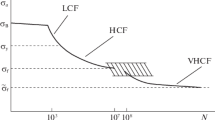Abstract
The ductile type of damage is a phenomenon now well understood. Once the fully coupled set of constitutive equations is identified, Damage Mechanics is a powerful tool to predict failure. Brittle materials do not exhibit such a damageable macroscopic behavior. Nevertheless, they still fail. On the idea that damage is localized at the microscopic scale, a scale smaller than the mesoscopic one of the Representative Volume Element (RVE), we propose a three-dimensional failure modeling for monotonic as well as for fatigue loading. We develop a two scale model of what we shall call brittle damage: at the microscopic scale, micro-cracks or micro-voids exhibit a damageable plastic-like behavior with no effect on the global (mesoscopic) elastic behavior. Microscopic failure is assumed to coincide with the RVE failure. This model turns out to represent quite well physical phenomena related to high cycle fatigue such as the mean stress effect, the nonlinear accumulation of damage, initial strain hardening or damage effect and the nonproportional loading effect for bi-axial fatigue. The model has been implemented as a post-processor computer code. A simplified identification procedure for the determination of the material properties is given.
Similar content being viewed by others
References
Benallal, A. et al. (1988). An integration algorithm and the corresponding consistent tangent operator for fully coupled elastoplastic and damage equations. Communications of Applied Numerical Methods 4, 731–740.
Berveiller, M. and Zaoui, A. (1980). Self-consistent schemes for heterogeneous solid mechanics. In Comportement Rhéologique et Structure des Matériaux, CR 15è coll. GFR, Paris.
Coffin, L.F. (1954). A study of the effects of cyclic thermal stresses in a ductile metal. Transaction of American Society of Mechanical Engineers 76, 931.
Crossland, B. (1956). Effect of large hydrostatic pressures on the torsional fatigue strength of an alloy steel. Proceedings of the International Conference on Fatigue Metals Institution of Mechanical Engineers, 138–149.
Dang Van, K. (1973). Sur la resistence à la fatigue des métaux. Sciences et Tecniques de l'Armement 47, 3ème Fascicule, 647–722.
Dufailly, J. (1995). Identification des lois de comportement à variables internes. Mémoire d'habilitation à diriger des recherches, Université Paris 6.
Dufailly, J. and Lemaitre, J. (1995). Modeling very low cycle fatigue. International Journal of Damage Mechanics 4.
Eshelby, J.D. (1957). The determination of the elastic field of an ellipsoidal inclusion and related problems. Proceedings of the Royal Society of London A 241, 376.
Hayhurst, D.R. and Leckie, F.A. (1973). The effect of creep constitutive and damage relationships upon the rupture time of a solid circular torsion bar. Journal of the Mechanics and Physics of Solids 21, 431–446.
Hult, J. and Broberg, H. (1974). Creep rupture under cyclic loading. Proc. II Bulgarian National Congress of Theoretical and Applied Mechanics, Varna.
Kachanov, L.M. (1958). Time of rupture process under creep conditions. Izv. Akad. NAUK. SSR — Otd. Nauk. 8, 26–31.
Kracinovic, D. and Fonseka, G.U. (1981). The continuous damage theory of brittle materials, Part 1 and 2. Journal of Applied Mechanics, 809–824.
Krempl, E. (1984). The hardening and rate dependant behavior of fully annealed AISI typa 304 stainless steel under biaxial in phase and out-of-phase strain cycling at room temperature. Journal of Engineering Materials and Technology 106, 376–384.
Kröner, E. (1961). On the plastic deformation of polycrystals. Acta Metallurgica 9, 155–161.
Ladevèze, P. and Lemaitre, J. (1984). Damage effective stress in quasi unilateral conditions, The 16th International Congress of Theoretical and Applied Mechanics, Lyngby, Denmark.
Lemaitre, J. (1971). Evaluation of dissipation and damage in metals submitted to dynamic loading. International Conference on Mechanical Behavior of Materials, The Society of Material Science, Kyoto, Japan.
Lemaitre, J. (1992). A Course on Damage Mechanics, Springer Verlag.
Lemaitre, J. and Chaboche, J.L. (1985). Mécanique des matériaux solides, Dunod, Paris. Mechanics of Solid Materials, Springer Verlag, Berlin.
Lemaitre, J. and Doghri, I. (1994). Damage 90: A post-processor for crack initiation. Computational Methods of Applied Mechanics Engineering 115, 197–232.
Lemaitre, J. and Sermage, J.P. (1997). One damage law for different mechanisms. Computational Mechanics 20, 84–88.
Liénard, C. (1989). Plasticité couplée à l'endommagement en conditions quasi-unilatérales pour la prévision de l'amorçage de fissures. Thèse de l'Université Paris 6.
Manson, S.S. (1954). Behavior of materials under conditions of thermal stress. NACA Technical Note, 2933.
Marquis, D. (1989). Phénoménologie et thermodynamique. Couplages entre thermoélasticité, plasticité, vieillissement et endommagement. Thèse d'État de l'Université Paris 6.
Murakami, S. and Ohno, N. (1978). A constitutive equation of creep damage in pollicristalline metals. IUTAM Colloquium Euromech 111, Marienbad.
Miner, M.A. (1945). Cumulative damage in fatigue. Journal of Applied Mechanics 14, A159–164.
Palmgren (1924). Endurance of ball-bearings. V. Deut. Igenieure 68, 339.
Pilvin, P. (1988). Identification des paramètres de modèles de comportement. Proc. Mecamat. on Inelastic Behavior of Solids, Besançon France.
Taira (1952). Lifetime of structures subjected to varying load and temperature. Creep in Structures (Edited by N.J. Hoff), Academic Press.
Author information
Authors and Affiliations
Rights and permissions
About this article
Cite this article
Lemaitre, J., Sermage, J. & Desmorat, R. A two scale damage concept applied to fatigue. International Journal of Fracture 97, 67–81 (1999). https://doi.org/10.1023/A:1018641414428
Issue Date:
DOI: https://doi.org/10.1023/A:1018641414428




